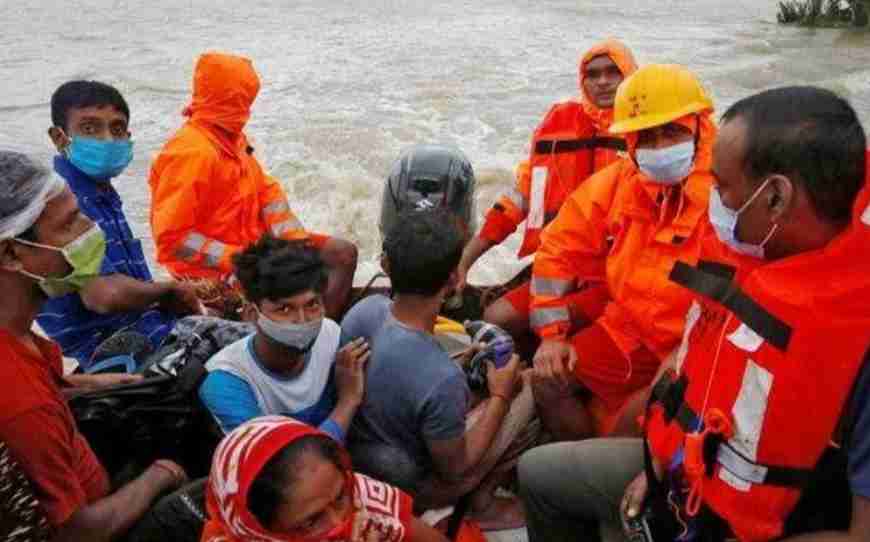
Introduction
- NDRF is a specialized force used during disasters that can be both natural and man-made. NDRF was formed under sections 44-45 of the Disaster Management Act 2005. The Bill was passed in the parliament in the year 2005 and the President of India gave his assent to the bill in 2006. NDRF’s motto is Aapada Seva Sadaiv Sarvatra which means to sustain disaster response service under all circumstances. NDRF headquarters is in Antyodaya Bhawan, New Delhi.
History
- NDRF foundation started with notable plans such as;
1. Yokohama Strategy Plan (1994):-

In 1994 member states of the United Nations and States met at the world conference for natural disaster reduction in the city of Yokohama, Japan from May 23rd – 27th 1994.
Reasons to trigger to form the plan of action: There was a sudden rise in the natural disaster. It was felt that the damages caused by the natural disaster had global repercussions and these affect the poor and the disadvantaged the most in the world.
2. Hyogo Framework For Action (2005):-

In January 2005, 168 governments adopted a 10-year plan to make the world safer from natural hazards at world conference on disaster reduction held in Hyogo, Japan. India was one of the countries that adopted the plan of action. The top priorities of Hyogo were to make disaster risk reductions priority, secondly to know the risks and take action, to build understanding and awareness among all.
These plans of action were mainly triggered in India because of three natural calamities such as:-
1. Orissa Super Cyclone:-

- On Oct 29,1999 Odisha cyclone also known as the Paradip, cyclone-hit Odisha with a wind speed of up to 250kmph. It is first detected in its low stage over the Gulf of Siam on the morning of October 24.
2. Gujarat Earthquake (2001):-
In 2001 Gujarat Earthquake also known as Bhuj Earthquake occurred on 26th January India on its 52nd Republic Day at 08:46 a.m. The epicenter was about 9km south-southwest of the village of chobari in Bhachau Taluka of Kutch district of Gujarat. The magnitude of the earthquake was 6.9 on the Richter scale.
It also destructed Aina Mahal and Prag Mahal.
3. Indian Ocean Tsunami:-
In the year 2004 Indian Ocean earthquake and tsunami occurred at 07:58 local time on 26 December, an earthquake that struck off the coast of Sumatra Island, Indonesia known as the Boxing Day Tsunami. Only three weeks after the tsunami 168 nations agreed to the Hyogo Framework for Action and paved the way for global cooperation for disaster risk reduction.
This led to the enactment of the Disaster Management Act on December 26th, 2005. The National Disaster Management Authority (NDMA) was headed by the Prime Minister of India and it is the apex body for disaster management in India. It envisions preventing, mitigating as well to preparing itself during an earthquake or any other calamity and should respond fast during a calamity. International talks cemented the idea of the need for such a task force. Then laws were formed to organize disaster response at the National, State, and District level. NDRF comes under the Ministry of Home Affairs and is Chaired by the Prime Minister of India.
NDRF was formed for a specialized purpose to give quick response during a natural and man-made disaster. These battalions are trained and equipped for response to chemical, biological, radiological, and nuclear emergencies (CBRN).
Composition Of NDRF
- National Disaster Response Force (NDRF) is a force of 16 battalions each consisting of 1149 personnel and consisting of 18 response teams consisting of 45 personnel each including engineers, technicians, electricians, and dog squads each battalion consists of 36 dogs 2 per Response team and medical personnel. NDRF Consists of three Border Security Force, three Central Reserve Police Force, two Central Industrial Security Force, two Indo-Tibetan Border Police, two Sashastra Seema Bal, and one of Assam Rifles.
NDRF unit | State | Battalion |
01 BN NDRF Guwahati | Assam | BSF |
02 BN NDRF Nadia 03 BN NDRF Cuttack | West Bengal | BSF CISF |
04 BN NDRF Vellore | Tamilnadu | CISF |
05 BN NDRF Pune | Maharashtra | CRPF |
06 BN NDRF Vadodara | Gujarat | CRPF |
07 BN NDRF Bhatinda | Punjab | ITBP |
08 BN NDRF Ghaziabad | Uttar Pradesh | ITBP |
09 BN NDRF Patna | Bihar | BSF |
10 BN NDRF Guntur | Andhra Pradesh | CRPF |
11 BN NDRF Varanasi | Uttar Pradesh | SSB |
12 BN NDRF Itanagar | Arunachal Pradesh | SSB |
13 BN NDRF | Jammu and Kashmir | ASSAM RIFLES |
Main Aims Of NDRF
NDRF’s main aim is to fight against all-natural disasters as well as man-made disasters are driven by the strategy of quick response during the disastrous situation.
Its main aim is to conduct search operations and rescue operations in disastrous situations to reduce and avoid major losses from hazards.
Eligibility Required To Join NDRF
A candidate must have at least a diploma or a bachelor’s degree or master’s degree in any stream from any recognized University to join NDRF. The minimum age to join NDRF is 18 years and the maximum age is 25 years. Only Indian citizens are eligible to apply for any position in NDRF.
A civilian is not eligible to join NDRF. The recruitment in NDRF is majorly for security and Reserve Forces of India such as Central Reserve Police Force (CRPF), Sashastra Seema Bal (SSB), Indo-Tibetan Border Police (ITBP), Border Security Force (BSF), and Central Industry Security Force (CISF).
Hierarchy And Promotions Of NDRF
S.N | Rank |
1 | Director-General |
2. | Additional Director-General |
2. | Inspector General |
3. | Deputy Inspector general |
4. | Commandant |
5. | Second-in-commandant |
6. | Deputy Commandant |
7. | Assistant Commandant |
8. | Subedar Major |
9. | Inspector |
10. | Sub-inspector |
11. | Assistant sub-inspector |
12. | Head Constable |
13. | Constable |
Under Which Ministry NDRF Is Functioning?
- The Disaster Management Division is the nodal division in the Ministry of Home Affairs for disaster management. It is headed by the Prime minister of India and can have up to nine other members, mainly the minister responsible for the workings of NDRF is Amit Shah, and the agency executive IPS Atul Karwal is the current Director-General of NDRF.
List Of Some Director General Of NDRF
- The head of NDRF is designated as DIRECTOR GENERAL. The DG of NDRF is an IPS officer on deputation from Indian Police Organization.
| S.N | Name | From | To |
| 1. | ATUL KARWAL (IPS) | 15-11-2021 | Till date |
| 2. | S. N PRADHAN (IPS) | 22-01-2019 | 15-11-2021 |
| 3. | SANJAY KUMAR (IPS) | 06-07-2017 | 31-12-2018 |
| 4. | R.K PACHNANDA (IPS) | 26-09-2016 | 06-07-2017 |
| 5. | O.P SINGH (IPS) | 01-09-2014 | 26-09-2016 |
| 6. | MAHBOOB ALAM (IPS) | 28-02-2014 | 31-08-2014 |
| 7. | KRISHNA CHAUDHARY (IPS) | 10-07-2013 | 27-02-2014 |
| 8. | DR.P.M NAIR | 24-08-2012 | 31-05-2013 |
Training Given To The NDRF Personnel
NDRF rescuers have been named as angels in disaster by fellow citizens they are given specialized training which is being conducted in Bhaba Atomic Research Centre, INDIAN NAVY, and in Himalayan Mountaineering Institute (HMI) as they are trained to protect every people in every disastrous situation. After personnel and officers are deputed to the NDRF they undergo a first respondent course for five months.
Later on, sections of personnel get advanced specialized training in deep diving, special search and rescue, and psycho-social intervention.
They are also trained to maintain the equipment and troubleshoot. The advanced course is given to face different situations namely CSSR (Collapsed Structure Search And Rescue), and MFR (Medical First Response), and they are trained for biological emergencies, landslides, etc. Some of the personnel further undergo specialized training with National and International institutions including those on chemical and biological warfare emergencies.
They are also trained to create awareness among the community members. The foundation of NDRF was recently laid in Nagpur, Maharashtra by Union Home Minister Amit Shah, based on National Fire Service College.
NDRF center is also located in Assam, West Bengal, Odisha, Tamil Nadu, Gujarat, Uttar Pradesh, Punjab, Bihar, Andra Pradesh, and Arunachal Pradesh.
Recent Response Acts By NDRF

- Cyclone Yaas- cyclone Yaas- made its landfall in Odisha on the afternoon of 26th May with heavy rainfall on the coastline of West Bengal and Odisha. A total number of 113 teams of NDRF was the highest ever number of teams carrying out the rescue operation and restoration after the cyclone. NDRF evacuated thousands of people to a safer place. NDRF works successfully with local administration and the state government. They rescued people as there were uprooted poles trees and many other dangers that possibly can harm their fellow citizens. Director Shri Satya Narayan Pradhan urges people to restrict their movements till the situation got better.
1. Mundka Fire:-
- A four-story building near Mundka metro station in New Delhi caught massive fire. 27 people were dead and 12 injured in the fragile incident. NDRF personnel carry out the rescue operation and it took 3-4 hours. Delhi police on Tuesday got one-day custody of three men including Mundka building owner Manish Lakra in connection with the massive fire that broke out inside the commercial building. The fire broke out mainly for the lack of fire fighting equipment and a blocked staircase, extensive use of glass inside the building generated heat which initiates the fire. NDRF helps to provide basic treatment and in the evacuation of people to a safer place.
2. Assam Flood:-

IN MAY 2022, a deadly flood-hit Assam, villages were submerged after three days of heavy rain caused the Brahmaputra River to burst its banks. It affects over 29 districts some of them were Bongaigaon, Baksha, etc. Nagaon was in the worst Situation Out of all.
NDRF rescued villagers and maintained proper social distancing due to the COVID-19 emergency. A total number of 11 searches and rescue teams of NDRF distributed rice, dal, and oils. They were also provided proper shelter, as everything was damaged like the educational institutions, embankments, bridges, and roads. Massive erosion spread out all over the affected area.
3. NDRF In Jammu And Kashmir:-
In September 2014, due to heavy rain, there was massive destruction so NDRF members circulated its helpline number and more than 4000 request was received. 2 search and rescue teams and the 7th Bn NDRF mobilized by roads to help the citizens. NDRF provided medical help, food packets, water as well as milk to the people.
NDRF during Amarnath Yatra: NDRF received special training to join the mountain rescue team with the start of the Amarnath pilgrimage to ensure the safety and convenience of devotees. They provided help for high altitude risk and areas which were prone to disaster. NDRF officials were provided with international gadgets and the main responsibility was given to Nazir Ahmad and Family Singh to select the team.
The team was provided by Carabineers, jumars, rappels, avalanche rods, helmets, first aid, and oxygen cylinders. They also got training in Basic life support systems and Cardiopulmonary Resuscitation.
NDRF also responds to road and train accidents.
NDRF Failure
In Kumbh Mela due to the communication gap between the police control room and the team of NDRF first aid reached very late and people suffered due to heavy rain and late response as stated NDRF was not fully prepared for the situation because of the location problem.
NDRF 7th battalion in Bhatinda failed to rescue a child in less time, a child named Fatehveer Singh only 2 years old fell into a 125-foot-deep borewell in Sangrur he was saved but it took much more time than usual.
NDRF Helpline Number: +91-9711077372.
Honors Received By NDRF Officials

CRPF ASI Mohan Lal who was killed while attempting to stop the Pulwama terror attack in February 2019 got a gallantry medal for outstanding service.
Police Medal for Meritorious Service was given on Republic Day 2022 to SHRI V.V.N Prasanna Kumar (Commandant),
Shri Begraj Meena (Deputy Commandant),
Subhas Chand (Assistant Commandant),
Kishan Ram (Inspector) for their outstanding service.
Movies That Showcase The Work Of NDRF

KEDARNATH movie showcases the work of NDRF and how they rescue people from the worst situation.
This movie shows the combination of a tragic real incident that happened in Kedarnath and a cute cupid love story. The movie shows the climactic floods that devastated the civilization of Uttarakhand in 2013 mainly because of the ever-growing impact of commercialization of hotels, malls, and tourism which disturb the ecological balance. NDRF chief said it was because of the glacial burst in Chamoli and the Nanda Devi glacier and because of the continuous rain. The infrastructure, lands, humans, and animals all of these were affected badly but NDRF helps to reduce the loss with the help of their response team.
Conclusion
- When our country faces some severe calamity, the central government has the responsibility to provide the necessary assistance and aid to the affected state and this was done by NDRF. The personnel in NDRF are trained in flood rescue, rope rescue, collapsed structure search rescue, and other activities to support people during calamities. The primary aims of disaster response are to rescue from immediate danger and to stabilization of the physical and emotional condition of the survivors.
Top 13 Facts We Need To Know About NDRF
In India every year on January 19 NDRF organizes their RAISING DAY.
NDRF raising day marks the formation of the disaster response force in the country back in 2006.
A two-day-long annual conference was held on 8th April 2022 on capacity building for disaster response. The discussion was held on how the country must be prepared and upgrade its fire services and how it should provide more aid and equipment to NDRF officials. This meeting was attended by Shri. Rajendra Singh and P.K. Mishra.
12 battalions of NDRF are stationed at 12 different locations across the country in order to cut down the response time for their deployment. NDMA will carry out the proactive deployment of these forces during a threatening disaster in consultation with state authorities this period is known as the preparedness period.
NDRF engages in creating public awareness they ensure to carry out mock exercises for villagers, local people, schools, etc. to face various disasters.
NDRF organizes workshops, seminars, and campaigns for creating awareness.
NDRF had 310 types of equipment mainly units like CSSR had 124type of equipment, the water rescue team had 12 types of equipment, the Mountaineering rescue team had 16 types of equipment, and the Medical Response team had 112 of them and CBRN had 46 types of equipment. They have UNMANNED AERIAL VEHICLE for all-weather and to face extreme conditions.
NDRF is located at 12 different places in the country based on the vulnerability profile of the regions.
Just one day before the appearance in the Kaun Banega crorepati 11 shoot NDRF rescued people from Bhiwandi’s earthquake.
The Japanese Prime Minister Shinzo Abe called out the team of NDRF and felicitated them. Japan called the natural disaster forces across the world and Indian NDRF forces were the only ones who stayed back to neutralize the threat and gave their valuable input to save Japan TRIPLE DISASTER. NDRF was praised globally for aiding Japan in 2011 when it was struck by an earthquake, tsunami, and a nuclear emergency.
In March 2011 NDRF provide rescue team and relief measures to the people who are affected by the mega earthquake and was without home, heat, electricity, food, and water.
The budgetary allocation under reliefs on account of natural disasters has been decreased this year. The amount for relief operations decreased from 1,538.03 crores to 1,511.93 crores in 2022-2023. The state allocation needs to be increased as NDRF can provide better preventive measures after and before the calamity. They can reduce the risk of disaster if the proper allocation of money was provided. The list of items and norms of assistance from SDRF and NDRF should be revised as it is outdated.
NDRF is suffering due to poor infrastructure and amenities. They also urged providing shelter near the location prone to disaster as it is not possible to reach soon from Mangalagiri to Bengaluru, Hyderabad, or Vijayawada.






